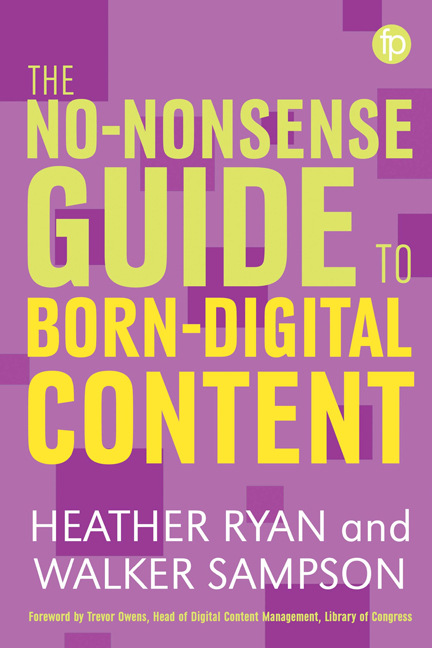Book contents
- Frontmatter
- Contents
- List of figures and tables
- Foreword
- Acknowledgements
- List of abbreviations
- Glossary
- Introduction
- 1 Digital information basics
- 2 Selection
- 3 Acquisition, accessioning and ingest
- 4 Description
- 5 Digital preservation storage and strategies
- 6 Access
- 7 Designing and implementing workflows
- 8 New and emerging areas in born-digital materials
- Conclusion
- References
- Appendix A Resources
- Appendix B Basic Unix command line prompts
- Index
8 - New and emerging areas in born-digital materials
Published online by Cambridge University Press: 08 June 2018
- Frontmatter
- Contents
- List of figures and tables
- Foreword
- Acknowledgements
- List of abbreviations
- Glossary
- Introduction
- 1 Digital information basics
- 2 Selection
- 3 Acquisition, accessioning and ingest
- 4 Description
- 5 Digital preservation storage and strategies
- 6 Access
- 7 Designing and implementing workflows
- 8 New and emerging areas in born-digital materials
- Conclusion
- References
- Appendix A Resources
- Appendix B Basic Unix command line prompts
- Index
Summary
The future has already happened.
(William Gibson, Cyberpunk, 1990)New technologies are always being experimented with and tested. We want to take a moment here to look forward to developments in software, hard - ware and network technologies that may impact on how the cultural heritage field works with born-digital materials. Some of these topics will be technologies already in place and operating and some are only in early stages of testing and research. By ‘looking forward’, therefore, we mean both technologies on the possible horizon and existing technologies which you may wish to learn about further in your own exploration through this field.
Storage
Magnetic storage has been a dominant mode of information storage for decades, and its prominence continues today. However, new storage technologies are being explored and hold considerable promise for expanding further the amount of data we can store – and perhaps more importantly, increasing the efficiency with which we can do it.
Some of the new technologies being researched in labs are storage at the atomic level, spin transport electronics or ‘spintronics’, which encodes information according to the direction an electron is spinning (rather than the absence or presence of a charge), and data storage in DNA, using the sequences of the molecule's internal structure to retain digital information.
These are fascinating developments, but what does this mean for archives and libraries? Let's first bear in mind that we have already seen one revolution in data storage – from magnetic to solid state. Solid state technology is used in everything from laptops and desktops to SD cards, smartphones and USB sticks. The core technology is a grid of cells that can enclose individual electrons, maintaining the charge status of the cell even when the device is turned off.
Despite the fact that magnetic media and solid state are completely different strategies for retaining data, the manner in which you process a USB stick, as opposed to a spinning hard drive or floppy disk, is nearly identical. In both cases, you will probably attach that device to your host computer, perhaps use a write blocker, and attempt to take a full-sector copy of the device that includes the file system metadata and volume arrangement.
- Type
- Chapter
- Information
- The No-nonsense Guide to Born-digital Content , pp. 165 - 176Publisher: FacetPrint publication year: 2018



